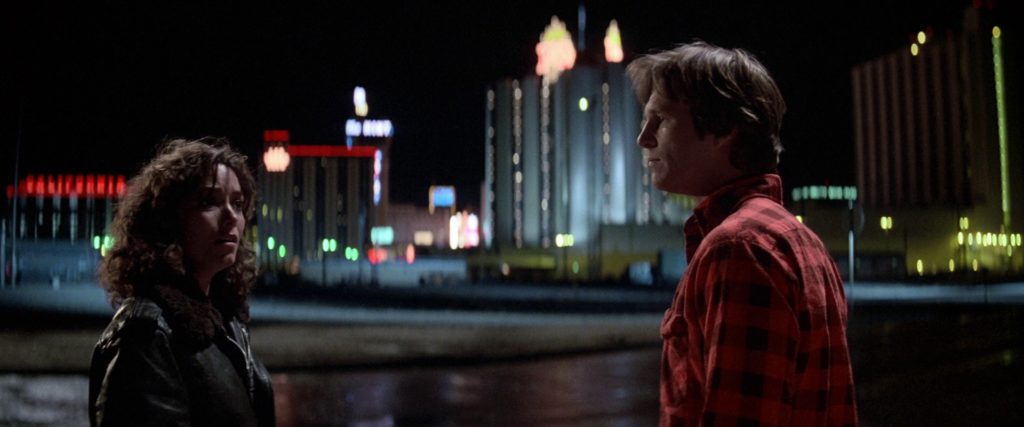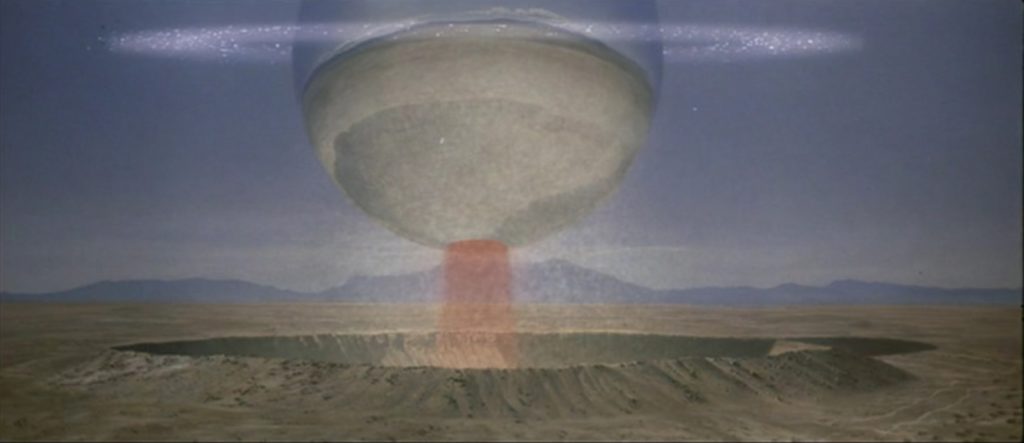If a filmmaker makes a name for themselves in the horror genre, it’s very difficult to convince the world they can do anything else, much as they might try. It’s been 30 years since David Cronenberg made a horror movie, for example, yet we still most associate him with the genre. Cronenberg, however, got out of the genre to critical acclaim; John Carpenter will forever be a horror/sci-fi guy, for good or ill. But in 1984, he took his stab at a mainstream Hollywood love story: Starman.
By 1981, Carpenter was on an amazing run of successes. Following his ostensible debut with 1976’s Assault on Precinct 13, he gave the world Halloween, The Fog, and Escape from New York, not to mention a critically acclaimed TV biopic about Elvis Presley and a made-for-TV thriller called Someone’s Watching Me. He was killing it, but after The Thing, his first movie for a major studio, turned out to be a bomb (despite now being hailed as perhaps his finest work), he was on a slide. 1983 saw a good-sized hit with Christine, but he needed to branch out; he needed to prove he could work in the studio system and made something far more palatable to mainstream audiences than The Thing. The original screenplay for Starman was written by Bruce A. Evans and Raynold Gideon, with Dean Riesner doing uncredited rewrites after Carpenter was attached, and this was the best chance he’d get for the big time. The movie would employ some astounding effects work from make-up and creature legends Stan Winston, Rick Baker, and Dick Smith, and visual effects by the folks at ILM. But at its heart, it was a story of grief and discovery and love without reason. In short, it was something Carpenter was not the most obvious choice to pull off.Karen Allen plays Jenny, a grieving young wife whose husband Scott (Jeff Bridges) has just died tragically. An alien spacecraft has intercepted the gold disc from the Voyager 2 probe and comes to Earth to make first contact with humanity. The U.S. government, in its infinite wisdom, shoots down the alien ship over Wisconsin, and the alien entity makes its way to Jenny’s house where it uses a piece of Scott’s hair and pictures and video of him to create a human form for itself, to the utter horror of an onlooking Jenny. The Starman sends a message to his people that humans are hostile and arranges a pickup, in the middle of Arizona. Jenny agrees to drive the alien across the country, all the while pursued by government agents.
The original screenplay for Starman was written by Bruce A. Evans and Raynold Gideon, with Dean Riesner doing uncredited rewrites after Carpenter was attached, and this was the best chance he’d get for the big time. The movie would employ some astounding effects work from make-up and creature legends Stan Winston, Rick Baker, and Dick Smith, and visual effects by the folks at ILM. But at its heart, it was a story of grief and discovery and love without reason. In short, it was something Carpenter was not the most obvious choice to pull off.Karen Allen plays Jenny, a grieving young wife whose husband Scott (Jeff Bridges) has just died tragically. An alien spacecraft has intercepted the gold disc from the Voyager 2 probe and comes to Earth to make first contact with humanity. The U.S. government, in its infinite wisdom, shoots down the alien ship over Wisconsin, and the alien entity makes its way to Jenny’s house where it uses a piece of Scott’s hair and pictures and video of him to create a human form for itself, to the utter horror of an onlooking Jenny. The Starman sends a message to his people that humans are hostile and arranges a pickup, in the middle of Arizona. Jenny agrees to drive the alien across the country, all the while pursued by government agents.  So we have a road movie, and one that uses the landscape of the middle of the country very effectively. Carpenter and director of photography Donald M. Morgan show us sweeping vistas and forested mountain ranges along various highways and byways, and within that it allows the story to be quite intimate, with Jenny forced to care for this helpless entity that looks like the man she loved and lost. It’s emotional manipulation on the part of the alien, but it knows it. Along the way, because the alien is learning about humanity and Earth customs for the first time, there’s quite a lot of comedy to be mined, from the Starman recognizing a yellow light means “drive faster” to the subtle eloquence of flipping someone the bird.But the Starman also teaches, rejecting the human norm of violence and killing, as evidenced by a powerful scene in which he brings a dead deer on the front of a hunter’s truck back to life, sucking out the bullets and the pain in the process. Why would you kill for sport? Why would you treat life so meaninglessly? This theme is explored further by the interactions and different approaches of two government officials: the thoughtful SETI scientist Mark Shermin (Charles Martin Smith) and NSA director George Fox (Richard Jaeckel). We invited the alien to Earth, and yet for national security reasons, it needs to be vivisected. The desire for discovery and the fear of its reality. The hypocrisy of humanity.
So we have a road movie, and one that uses the landscape of the middle of the country very effectively. Carpenter and director of photography Donald M. Morgan show us sweeping vistas and forested mountain ranges along various highways and byways, and within that it allows the story to be quite intimate, with Jenny forced to care for this helpless entity that looks like the man she loved and lost. It’s emotional manipulation on the part of the alien, but it knows it. Along the way, because the alien is learning about humanity and Earth customs for the first time, there’s quite a lot of comedy to be mined, from the Starman recognizing a yellow light means “drive faster” to the subtle eloquence of flipping someone the bird.But the Starman also teaches, rejecting the human norm of violence and killing, as evidenced by a powerful scene in which he brings a dead deer on the front of a hunter’s truck back to life, sucking out the bullets and the pain in the process. Why would you kill for sport? Why would you treat life so meaninglessly? This theme is explored further by the interactions and different approaches of two government officials: the thoughtful SETI scientist Mark Shermin (Charles Martin Smith) and NSA director George Fox (Richard Jaeckel). We invited the alien to Earth, and yet for national security reasons, it needs to be vivisected. The desire for discovery and the fear of its reality. The hypocrisy of humanity.  But sci-fi allegory aside, Starman is a rather profound love story. It’s not a meet-cute where the man and woman hate each other but romance grows; it’s a woman having her entire existence and thoughts about the universe blown wide open in the form of her dead husband—whom she watched grow from a fetus to a man in seconds, mind you—and putting her grief behind her for a moment to do something greater. It’s a way for her to say goodbye to Scott, who died suddenly, and to spend a bit more time with him, even just in physical space. And the Starman learns what love is by Jenny’s feelings for Scott, and that helps it learn humanity isn’t merely fear and hate. It’s a deeply sad, deeply moving way to do an alien on Earth story.
But sci-fi allegory aside, Starman is a rather profound love story. It’s not a meet-cute where the man and woman hate each other but romance grows; it’s a woman having her entire existence and thoughts about the universe blown wide open in the form of her dead husband—whom she watched grow from a fetus to a man in seconds, mind you—and putting her grief behind her for a moment to do something greater. It’s a way for her to say goodbye to Scott, who died suddenly, and to spend a bit more time with him, even just in physical space. And the Starman learns what love is by Jenny’s feelings for Scott, and that helps it learn humanity isn’t merely fear and hate. It’s a deeply sad, deeply moving way to do an alien on Earth story.  Starman sadly didn’t do the business anyone was hoping, opening at number six at the box office the same weekend as David Lynch’s Dune and the week after 2010: The Year We Make Contact. Just like The Thing‘s box office was hurt by E.T.: The Extra-Terrestrial in ’82, Starman was hampered by too many aliens in theaters. And as the years have gone on, people tend to call this a lesser Carpenter outing, due to its soft-edges and less cynical approach. But Bridges did receive an Oscar nomination for Best Actor for his role, the only Oscar nomination for a John Carpenter movie.While not as iconic or endemic of the director as some of Carpenter’s other films, Starman nevertheless proved he could work within that system and turn out a good movie, even if it didn’t terrify or menace. But that’s what the public expected from him, horror fans not accepting any other type of movie. It still feels like a John Carpenter movie, though, which is the mark of a great filmmaker, regardless of genre.
Starman sadly didn’t do the business anyone was hoping, opening at number six at the box office the same weekend as David Lynch’s Dune and the week after 2010: The Year We Make Contact. Just like The Thing‘s box office was hurt by E.T.: The Extra-Terrestrial in ’82, Starman was hampered by too many aliens in theaters. And as the years have gone on, people tend to call this a lesser Carpenter outing, due to its soft-edges and less cynical approach. But Bridges did receive an Oscar nomination for Best Actor for his role, the only Oscar nomination for a John Carpenter movie.While not as iconic or endemic of the director as some of Carpenter’s other films, Starman nevertheless proved he could work within that system and turn out a good movie, even if it didn’t terrify or menace. But that’s what the public expected from him, horror fans not accepting any other type of movie. It still feels like a John Carpenter movie, though, which is the mark of a great filmmaker, regardless of genre.  Starman is available now on Blu-ray from Scream Factory with a new retrospective documentary and a classic commentary featuring Carpenter and Bridges. It’s a very worthy addition to your Carpenter shelf.
Starman is available now on Blu-ray from Scream Factory with a new retrospective documentary and a classic commentary featuring Carpenter and Bridges. It’s a very worthy addition to your Carpenter shelf.
Images: Columbia/Shout! Factory
Kyle Anderson is the Associate Editor for Nerdist. You can find his film and TV reviews here. Follow him on Twitter!

